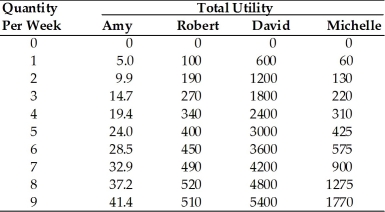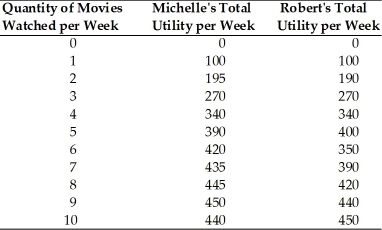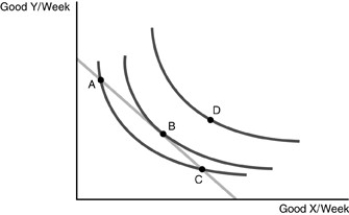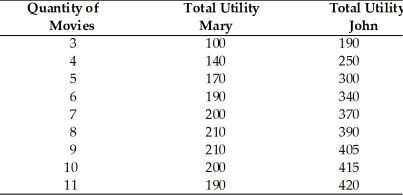A) 16 utils of satisfaction.
B) 9 utils of satisfaction.
C) 12 utils of satisfaction.
D) The answer cannot be determined with this information.
F) A) and C)
Correct Answer

verified
Correct Answer
verified
Multiple Choice
The marginal rate of substitution is
A) equal to unit changes in the quantities of both goods so that utility rises.
B) the slope of the budget line at all points.
C) the change in the quantity of one good that just offsets a unit change in another good, keeping utility constant.
D) found by adding additional units.
F) C) and D)
Correct Answer

verified
Correct Answer
verified
Multiple Choice
 -Refer to the above table. David's utility schedule is characterized by
-Refer to the above table. David's utility schedule is characterized by
A) diminishing marginal utility.
B) increasing marginal utility.
C) constant marginal utility.
D) decreasing marginal utility.
F) A) and D)
Correct Answer

verified
Correct Answer
verified
Multiple Choice
A higher price for a good implies that
A) the marginal utility of the good has declined.
B) the total value of the good to the consumer has increased.
C) the sacrifice of utility of another good has increased.
D) the marginal utility of another good has decreased.
F) A) and D)
Correct Answer

verified
Correct Answer
verified
Multiple Choice
 -Refer to the above table. The marginal utility of the 6th movie for Michelle is
-Refer to the above table. The marginal utility of the 6th movie for Michelle is
A) 25 units of utility.
B) 30 units of utility.
C) 35 units of utility.
D) 40 units of utility.
F) B) and C)
Correct Answer

verified
Correct Answer
verified
Multiple Choice
When the price of a normal good decreases, people increase their consumption of the good. The reason is
A) the law of diminishing marginal utility.
B) the substitution and income effects.
C) the substitution effect only.
D) the income effect only.
F) B) and C)
Correct Answer

verified
Correct Answer
verified
Multiple Choice
Regretting a last unit of consumption of cake implies that
A) the total utility from eating cake was negative.
B) cake is an inferior good.
C) the marginal utility of the last unit of cake consumed was negative.
D) the demand curve for cake is horizontal.
F) C) and D)
Correct Answer

verified
Correct Answer
verified
Multiple Choice
When an individual's purchasing power changes due to a change in the price of a good or service, this is referred to as
A) marginal effect.
B) real-income effect.
C) substitution effect.
D) utility effect.
F) A) and C)
Correct Answer

verified
Correct Answer
verified
Multiple Choice
If you could pay for a product according to the marginal utility that you gain from additional consumption, then as you consume more of a product the price you pay would
A) remain the same.
B) increase.
C) be deferred.
D) decline.
F) A) and D)
Correct Answer

verified
Correct Answer
verified
Multiple Choice
If the last $5 spent on movies added 30 utils to your total satisfaction and the last $8 spent on books add 64 utils,
A) you can increase your satisfaction by buying more books and seeing fewer movies.
B) your total satisfaction is 94 utils.
C) you can increase your satisfaction by buying fewer books and seeing more movies.
D) you can increase your satisfaction by buying only books.
F) A) and B)
Correct Answer

verified
Correct Answer
verified
Multiple Choice
The price of a can of soft drink is $1.25 and the marginal utility of the second can consumed is 10 utils. The marginal utility of the third donut is 4 utils. You should only consume the third donut if the price of the donut is less than or equal to
A) $0.41.
B) $0.625.
C) $0.25.
D) $0.50.
F) B) and D)
Correct Answer

verified
Correct Answer
verified
Multiple Choice
Dr. Rodriguez is consuming beer and wine. At his current level of consumption, the marginal utility per dollar is 30 units for beer and 15 units for wine. Dr. Rodriguez should
A) consume twice as much beer as wine.
B) consume twice as much wine as beer.
C) increase his consumption of beer relative to wine.
D) increase his consumption of wine relative to beer.
F) All of the above
Correct Answer

verified
Correct Answer
verified
Multiple Choice
The quantity of good M is measured along the vertical axis, and the quantity of good N is measured along the horizontal axis. If the prices of both goods M and N declines by 50% each, then the budget line
A) shifts inward to the left by 50%.
B) shifts outward to the right by 50%.
C) shifts outward to the right by 100%.
D) rotates clockwise by 180 degrees.
F) All of the above
Correct Answer

verified
Correct Answer
verified
Multiple Choice
 -Refer to the above figure. Given the indifference map and budget constraint represented above, what are all possible points at which that the individual can consume?
-Refer to the above figure. Given the indifference map and budget constraint represented above, what are all possible points at which that the individual can consume?
A) Points A and C only
B) Point B only
C) Point D only
D) Points A, B and C only
F) None of the above
Correct Answer

verified
Correct Answer
verified
Multiple Choice
The change in total utility derived when a customer consumes one more unit of a good or service is called
A) total utility.
B) marginal utility.
C) average utility.
D) final utility.
F) B) and C)
Correct Answer

verified
Correct Answer
verified
Multiple Choice
 -Refer to the above table. The marginal utility of the 8th movie for Robert is
-Refer to the above table. The marginal utility of the 8th movie for Robert is
A) 30 units of utility.
B) 20 units of utility.
C) 420 units of utility.
D) 5 units of utility.
F) A) and D)
Correct Answer

verified
Correct Answer
verified
Multiple Choice
The fact that the price of diamonds is higher than the price of water
A) cannot be explained by behavioral economics or consumer choice theory.
B) is an outcome of irrational behavior in consumer choice theory.
C) can be explained only by behavioral economics but not by consumer choice theory.
D) can be explained as the outcome of a consumer optimum in consumer choice theory.
F) All of the above
Correct Answer

verified
Correct Answer
verified
Multiple Choice
 -According to the above table, John's marginal utility from watching the 9th movie is
-According to the above table, John's marginal utility from watching the 9th movie is
A) 405 units of utility.
B) 0 units of utility.
C) 15 units of utility.
D) 10 units of utility.
F) B) and C)
Correct Answer

verified
Correct Answer
verified
Multiple Choice
If the price of a product increases, then
A) the budget line rotates and the optimal quantity demanded, which corresponds to the higher price, decreases.
B) the budget line rotates and the optimal quantity demanded, which corresponds to the higher price, increases.
C) the budget line shifts outward and the optimal quantity demanded, which corresponds to the higher price, decreases.
D) the budget line shifts inward and the optimal quantity demanded, which corresponds to the higher price, increases.
F) A) and D)
Correct Answer

verified
Correct Answer
verified
Multiple Choice
Diminishing marginal utility means that as more of a good is consumed,
A) the rate at which total utility increases starts to diminish.
B) the rate at which total utility increases stays the same.
C) the rate at which total utility increases starts to increase.
D) there is no impact on the rate of change of total utility.
F) A) and D)
Correct Answer

verified
Correct Answer
verified
Showing 221 - 240 of 457
Related Exams